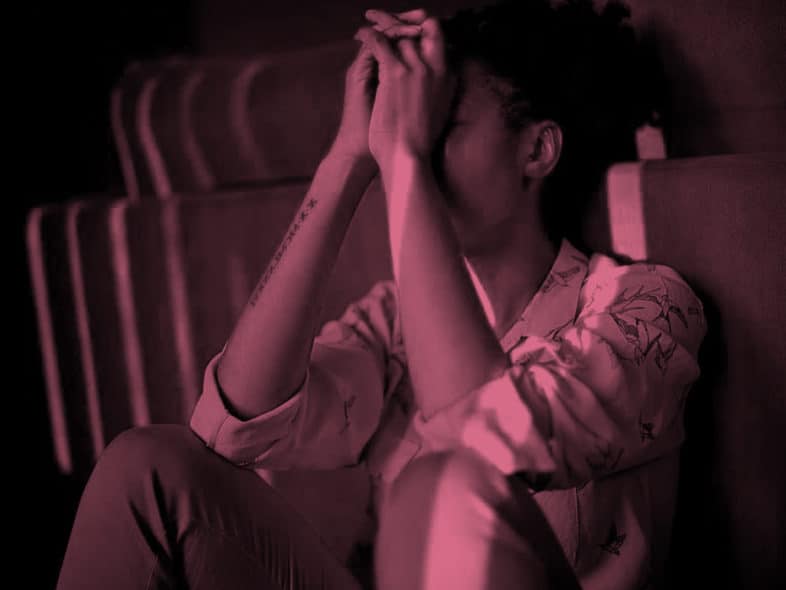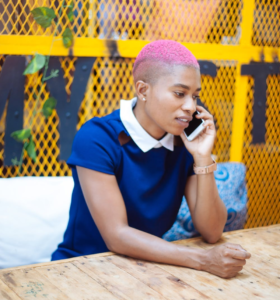 By Armando Sanchez of “Gay Men and Blog”
By Armando Sanchez of “Gay Men and Blog”
“I know sometimes you feel alone. I know some nights you wait by your phone. I know you wish you had somebody to hold. It don’t have to be lonely being alone” – “Lonely” by Chloe x Halle
These lyrics ruveal what many of us queer folk may experience during quarantine – the weight of our loneliness. The next part of the song, however, is the real gag: “Who are you when no one’s watching? You close the door to your apartment. Are you afraid of the silence? Are you afraid of what you’ll find in it?”
Chloe x Halle didn’t have to go in on us like that but I’m glad they did.
During this time, we are forced to reckon with our thoughts, fears, and truths, all while continuing to bear witness to the targeted violence against our Black, brown, and trans siblings. We want to reach out and be with friends and (chosen) family for support, comfort, and healing, but social distancing complicates something so normal and essential to our life. Another barrier that exists in communities of color is the stigma around mental health and talking openly about our feelings to others. Saving face, avoiding airing out dirty laundry, and putting on an emotional front are some ways in which mental health is negatively stigmatized in our communities.
It’s important to understand that there are healthy and effective ways to manage our loneliness and that we don’t have to navigate it alone. Let’s untuck this topic a bit further.
Fruit of the gloom
Brené Brown, whom I consider to be the Beyoncé of social work, has a podcast called “Unlocking Us.” In an episode on loneliness and connection, she talks to Dr. Vivek Murthy, former U.S. Surgeon General and author, where he describes loneliness in two ways.
Scientifically, loneliness is “the gap between the connections that you need and the social connections that you have.” However, most people express loneliness in a descriptive way, with statements like, “I feel like I’m carrying this entire load all by myself,” “I feel like if I disappear tomorrow, nobody would even care,” and “I feel like I’m invisible.”
 I live by myself and there have been times during quarantine when I’ve gone days without being able to see friends in person. My loneliness can feel like a looming presence in my apartment, and my unmet desire for social and physical connection is something I confront on an almost daily basis.
I live by myself and there have been times during quarantine when I’ve gone days without being able to see friends in person. My loneliness can feel like a looming presence in my apartment, and my unmet desire for social and physical connection is something I confront on an almost daily basis.
As queer people of color, we may not be unfamiliar in dealing with loneliness and the lack of meaningful and genuine connections. Growing up, there could have been 100 people in a room and 99 of them didn’t know you were queer, but the one that did and accepted you, became a safe haven and oasis. This person could have been a best friend, prima, teacher, or romantic partner. They were there to provide comfort, laughter, and love when we needed it most. We still need all of those things, but because of COVID-19 and social distancing, we are all on a journey through our own desert in search of an oasis of connection.
So, how do we cope?
Acknowledge the loneliness, don’t internalize it
My approach to manage my loneliness is to message 3-5 people whom I care about. A simple “Hey girl, how are you?” usually opens a line of communication with at least one person within minutes. These virtual connections allow me to maintain my friendships during quarantine and relieve my loneliness, even if temporarily.
Meaningful connections with others are an essential part of our human experience and overall health. However, it is not uncommon for queer people to claim or believe that we don’t need anyone to be happy. This could stem from having to live a closeted life that made it difficult to build full and honest connections with those around us.
However, just as coming out provides a sense of liberation, so can the acknowledgement of our loneliness. When we name our demons, we reclaim our power and ability to slay them. We are not alone. We are all doing our best to maintain connections that keep life joyous and full during quarantine.
Our self-talk can be overactive during this time, as well. It has the potential to go to a dark place where we internalize false beliefs such as “No one cares about me,” “I can’t get through this,” or “There is no point in continuing on.” To counter these false beliefs, actively remember that this is temporary, that you are loved, and that there are people in your life who care about you and want to help. We help ourselves by letting others be there for us when we need them.
If you or anyone you know reaches a point where loneliness feels like despair, hopelessness, or thoughts of suicide, please call the National Suicide Prevention Lifeline (1–800–273–8255) or the TrevorLifeline (1–866–488–7386) to receive immediate help and support.
You gotta feel to heal
Our meaningful connections with others require honesty, trust, and vulnerability. To be emotionally and openly vulnerable is not weakness; it’s necessary. Emotional vulnerability allows us to be authentic in our relationships. It creates a pathway for us to release fear and shame from our heart to make room for love. When we practice vulnerability with ourselves and others, we pave roads that lead to deeper, fulfilling, and healing connections. These connections can lift us up and guide us from dark, lonely places.
The following 3 practices can help establish a life of vulnerability and connection:
 1. Process and reflect on emotions (the challenging ones, as well as the positive). The exploration of emotions can feel like a deep dive into depths we aren’t used to. I like to think of processing and reflecting as emotional cave diving. Just as tools exist to keep cave divers safe in their journey; there are tools for safe emotional cave diving. These include friends, family, partners, mental health professionals, our patterns of thinking, our resiliency, our spirituality, and self-care, to name a few. As you dive into the water in acknowledgement of your emotions, remember that while you may feel lonely, you are not alone. There is an exit on the other side of this emotional cave. When you emerge from the water, you may find a renewed sense of self, life, and possibilities.
1. Process and reflect on emotions (the challenging ones, as well as the positive). The exploration of emotions can feel like a deep dive into depths we aren’t used to. I like to think of processing and reflecting as emotional cave diving. Just as tools exist to keep cave divers safe in their journey; there are tools for safe emotional cave diving. These include friends, family, partners, mental health professionals, our patterns of thinking, our resiliency, our spirituality, and self-care, to name a few. As you dive into the water in acknowledgement of your emotions, remember that while you may feel lonely, you are not alone. There is an exit on the other side of this emotional cave. When you emerge from the water, you may find a renewed sense of self, life, and possibilities.
2. Allow yourself to cry. Crying is our body’s natural way of processing emotions, both positive and negative. I usually feel better after a good, ugly cry. Crying, however, has been demonized as a shameful act of weakness. To fully process our emotions, we have to allow our tears to fall, and with them, the emotions that stir within. If crying doesn’t come naturally to you at this time, you can try what I do, which is to watch a movie that gets me emotional to the point of tears. In my experience, crying during a movie can have a similar emotional relief as crying in response to what’s happening in my own life.
 3. Talk to friends and family. Loneliness can make us believe that we are alone, which further feeds the sense of loneliness. We can break this cycle by reaching out and opening up to friends and family. Reach out and be open and vulnerable with them. They may not have the capacity to be available to support all of the time, but this does not mean that you or your emotions are a burden. People who care about you want to be there for you when they can be. Take time to check in with them and see how they’re doing, as well. Mutual support is key in close relationships.
3. Talk to friends and family. Loneliness can make us believe that we are alone, which further feeds the sense of loneliness. We can break this cycle by reaching out and opening up to friends and family. Reach out and be open and vulnerable with them. They may not have the capacity to be available to support all of the time, but this does not mean that you or your emotions are a burden. People who care about you want to be there for you when they can be. Take time to check in with them and see how they’re doing, as well. Mutual support is key in close relationships.
Escape the loneliness rut
Loneliness, and the monotony of quarantine life, can put us in a state of stagnation. Change up your routine and escape this rut by adopting some of the following suggestions, or coming up with your own. Please continue to follow physical distancing ordinances in your area.
Physical Activities
- Rent a bike and ride on a trail
- Go on a picnic with a view
- Take a walk in nature
- Go on a mural tour around town
- Take a scenic drive
- Create a virtual takeout food tour week with friends
- Get one or multiple plants
- Rearrange your living space
- Get creative (draw, paint, craft, cook, sing, dance, etc.)
Emotional Activities
- Watch a movie or show that provides a different range of emotion — joy, suspense, fantasy, excitement, nostalgia, etc.
- Create a care package for a friend or family member
- Write messages of gratitude to others and/or yourself
- Meditate or engage in a mindfulness activity
- Journal or write in free-flow form for 5 minutes
- Pray or speak into the universe
Reflection Questions
Managing loneliness, along with all of our other emotions, may seem difficult or impossible at times. To help in this process, spend a few minutes reflecting on one or more of the following questions:
- What are some of the emotions that I am feeling right now? (It may help to write them down.)
- With whom do I feel comfortable talking to about this? OR Who would be sympathetic about what I feel if I were to share openly with them?
- What place or activity usually helps to distract me in a positive, healthy, and safe way?
- If I were to need help from a professional, am I open to seeking that help? If not, what would help me get closer to reaching out?
Resource Links
- National Suicide Prevention Lifeline
- TrevorLifeline
- Crisis Text Line — text “HELLO” to 741741
- Suicide Prevention: Signs and Symptoms from The National Institute of Mental Health
???? Gay Men & Blog
This article was originally posted to Gay Men & Blog on Medium, a blog dedicated to the growth and empowerment of gay men to lead a life of love and fulfillment. Read more articles by clicking on the links below.
Self-Care | Emotional Numbing | Complicated Faith | Body Confidence | Body Image | Loneliness | Ghosting | Self-Talk | Self-Worth Part 2 | Self-Worth Part 1
Follow @GayMenAndBlog on Instagram and Twitter. Thank you for your readership.



